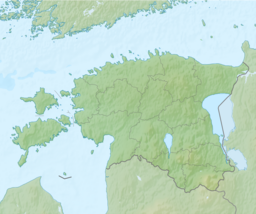
Viljandi is a town and municipality in southern Estonia with a population of 17,407 in 2019. It is the capital of Viljandi County and is geographically located between two major Estonian cities, Pärnu and Tartu. The town was first mentioned in 1283, upon being granted its town charter by Wilhelm von Endorpe. The town became a member of the Hanseatic League at the beginning of the 14th century, and is one of five Estonian towns and cities in the league. The once influential Estonian newspaper Sakala was founded in Viljandi in 1878.

Viljandi County is one of 15 counties of Estonia. It is located in southern Estonia bordering Pärnu, Järva, Jõgeva, Tartu and Valga counties.

Lake Peipus is the largest trans-boundary lake in Europe, lying on the border between Estonia and Russia.

Jõgeva County is one of 15 counties of Estonia. It is situated in eastern part of the country and borders Ida-Viru County to the north-east, Lake Peipus to the east, Tartu County to the south, Viljandi County to the south-west, Järva County to the north-west and Lääne-Viru County to the north.

Lääne-Viru County is one of 15 counties of Estonia. It is in northern Estonia, on the south coast of the Gulf of Finland. In Estonian, lääne means western and ida means east or eastern. Lääne-Viru borders Ida-Viru County to the east, Jõgeva County to the south, and Järva and Harju counties to the west. In January 2013, Lääne-Viru County had a population of 58,806: 4.5% of the population in Estonia.

Tartu County is one of 15 counties of Estonia.

The river Narva, formerly also Narova flows 77 kilometres (48 mi) north into the Baltic Sea and is the largest Estonian river by discharge. A similar length of land far to the south, together with it and a much longer intermediate lake, altogether forms the Estonia-Russia border.

Põlva County is one of 15 counties of Estonia. It is situated in south-eastern part of the country and borders Tartu, Valga and Võru counties. 28,507 people live in Põlva County – constituting 2.3% of the total population in Estonia.

Valga County is a first-level administrative unit and one of 15 counties of Estonia. It comprises the former area of Valga District. The present-day county was created on 1 January 1990. The capital and largest town of Valga County is Valga, followed by Tõrva and Otepää. It is situated in the southern part of the country and borders Põlva and Võru County to the east, Latvia to the south and west, and Viljandi and Tartu County to the north. 29,944 people live in Valga County.

Lake Ülemiste is the largest of the lakes surrounding Tallinn, Estonia. Ülemiste is the main part of the Tallinn water supply system, which supplies the city with most of its drinking water. The lake is fed mostly by Kurna stream and the Pirita River, through the Vaskjala–Ülemiste canal.

Lake Võrtsjärv is a lake in southern Estonia with an area of 270 km² (104 mi²).

Otepää is a town in Valga County, southern Estonia, it is the administrative centre of Otepää Parish. Otepää is a popular skiing resort, popularly known as the "winter capital" of Estonia. During the 2005–2006 season it became the site for FIS Cross-Country World Cup events.

Harku Lake is a 162.9 ha lake on the western border of Tallinn, Estonia. It has an average depth of 1.6 m (5.2 ft) and a maximum depth of 2.5 m (8.2 ft).

Mustvee is a town in Mustvee Parish, Estonia. It lies on the shore of Lake Peipus in Jõgeva County. Its population of 1,600 is approximately half Estonian and half Russian. The name of Mustvee was first recorded in 1343 at the time of reign of Livonian order. It became a haven for Russian Old Believers after the Russian government declared them outlaws in 1658. Mustvee has held fairs for the past two centuries. Due to its position at the broadest part of the lake, this traditional fishing town is increasingly popular as a tourist centre. The new Harbor of Mustvee was opened 18.12.2014.
The Tallinn offensive was a strategic offensive by the Red Army's 2nd Shock and 8th armies and the Baltic Fleet against the German Army Detachment Narwa and Estonian units in mainland Estonia on the Eastern Front of World War II on 17–26 September 1944. Its German counterpart was the abandonment of the Estonian territory in a retreat codenamed Operation Aster.

Kuremaa is a small borough in Jõgeva Parish, Jõgeva County in eastern Estonia. It lies 10 km from Jõgeva, near the northern shore of Lake Kuremaa, the 11th largest lake in Estonia. Kuremaa features an estate that was owned by the von Oettingen family until the early 20th century. Part of the estate's manor house is now a museum, its windmill in neighbouring Mooritsa village is a popular landmark, and its terraced gardens reach down to the shore of Lake Kuremaa.

Põhja-Kõrvemaa Nature Reserve is a protected area in Harju County, Northern Estonia, some 50 km east of Tallinn. With an area of 130.9 km2, it is the third largest nature reserve in Estonia. Dominated by forests and bogs, it aims to protect rare and endangered species, their habitats, and valuable natural landscapes.

Alam-Pedja Nature Reserve is the largest nature reserve in Estonia. It is a vast wilderness area which covers 342 km2 and consists of a complex of 5 large bogs separated by unregulated rivers, their floodplains, and extensive forests. The nature reserve aims to protect diverse ecosystems and rare species, mainly through preserving the natural development of forests and bogs and securing the continuing management of semi-natural floodplain grasslands.

Estonia, officially the Republic of Estonia, is a country in Northern Europe. It is bordered to the north by the Gulf of Finland across from Finland, to the west by the Baltic Sea across from Sweden, to the south by Latvia, and to the east by Lake Peipus and Russia. The territory of Estonia consists of the mainland and of 2,222 islands on the eastern coast of the Baltic Sea, covering a total area of 45,227 km2 (17,462 sq mi), the land area is 43,432 km², and is influenced by a humid continental climate. Estonia belongs to the Baltic states with Latvia and Lithuania, and it is the smallest of the states both in land area and population. Tallinn, the capital of Estonia, and Tartu are the largest cities and urban areas in the country. Other notable cities include Narva, Pärnu, Kohtla-Järve and Viljandi. The official language of the country, Estonian, is the second-most-spoken Finnic language.

The Kurtna Lake District is located in north-eastern Estonia. It consists of about 40 lakes within an area of 30 hectares. The lakes were formed while the area was glaciated.




















